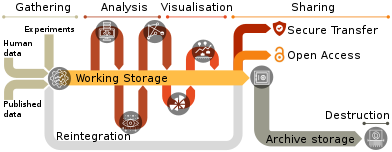E-research
The term e-Research (alternately spelled eResearch) refers to the use of information technology to support existing and new forms of research. This extends cyber-infrastructure practices established in STEM fields such as e-Science to cover other all research areas, including HASS fields such as digital humanities.[1]
Principles

Practices in e-Research typically aim to improve efficiency, interconnectedness and scalability across the full research data lifecycle: collection, storage, analysis, visualisation and sharing of data.[2]
E-Research therefore involves collaboration of researchers (often in a multi-disciplinary team), with data scientists and computer scientists, data stewards and digital librarians, and significant information and communication technology infrastructure.[3]
In addition to human resources, it often requires the physical infrastructure for data-intensive activities, often using high performance computing systems such as grid computing.[3]
Applications
Examples of e-Research problems range across disciplines which include:
- Modelling of ecosystems or economies
- Exploration of human genome structures
- Studies of large linguistic corpora
- Integrated social policy analyses
In Australia
Specialist services, centres or programmes instituted to support Australian data and technology intensive research operate under the umbrella term: eResearch. In March 2012, representatives from these eResearch groups came together to discuss the need build a "collaborative program to strengthen eResearch and address issues facing the sector nationally".[4] The Australian eResearch Organisation (AeRO) emerged from this forum as "a collaborative organisation of national and state-based research organisations to advance eResearch implementation and innovation in Australia".[5] Professionals working in Australian eResearch annually convene a conference known as: eResearch Australasia.[6]
See also
References
- Burton, Orville; Appleford, Simon (2009-01-01). "Cyberinfrastructure for the Humanities, Arts, and Social Sciences". EDUCAUSE Center for Applied Research - Research Bulletin. 2009 (1).
- Gupta, Shivam; Müller-Birn, Claudia (2018-08-06). "A study of e-Research and its relation with research data life cycle: a literature perspective". Benchmarking: An International Journal. 25 (6): 1656–1680. doi:10.1108/bij-02-2017-0030. ISSN 1463-5771.
- "e-Research Collaboration - Theory, Techniques and | Murugan Anandarajan | Springer". www.springer.com. Retrieved 2016-01-15.
- "Intersect Newsletter, 6 March 2012". Intersect Australia. Retrieved 14 January 2016.
- "About". Australian eResearch Organisation (AeRO). Retrieved 14 January 2016.
- "About". eResearch Australasia Conference. Retrieved 15 January 2016.
External links
- New Zealand eScience Infrastructure (NeSI)
- Auckland Centre for eResearch
- eResearch, the University of Michigan
- Research Paper Service
- Oxford e-Research Centre
- University of Cape Town eResearch Centre
- Centre for eResearch and Digital Innovation (CeRDI) at Federation University